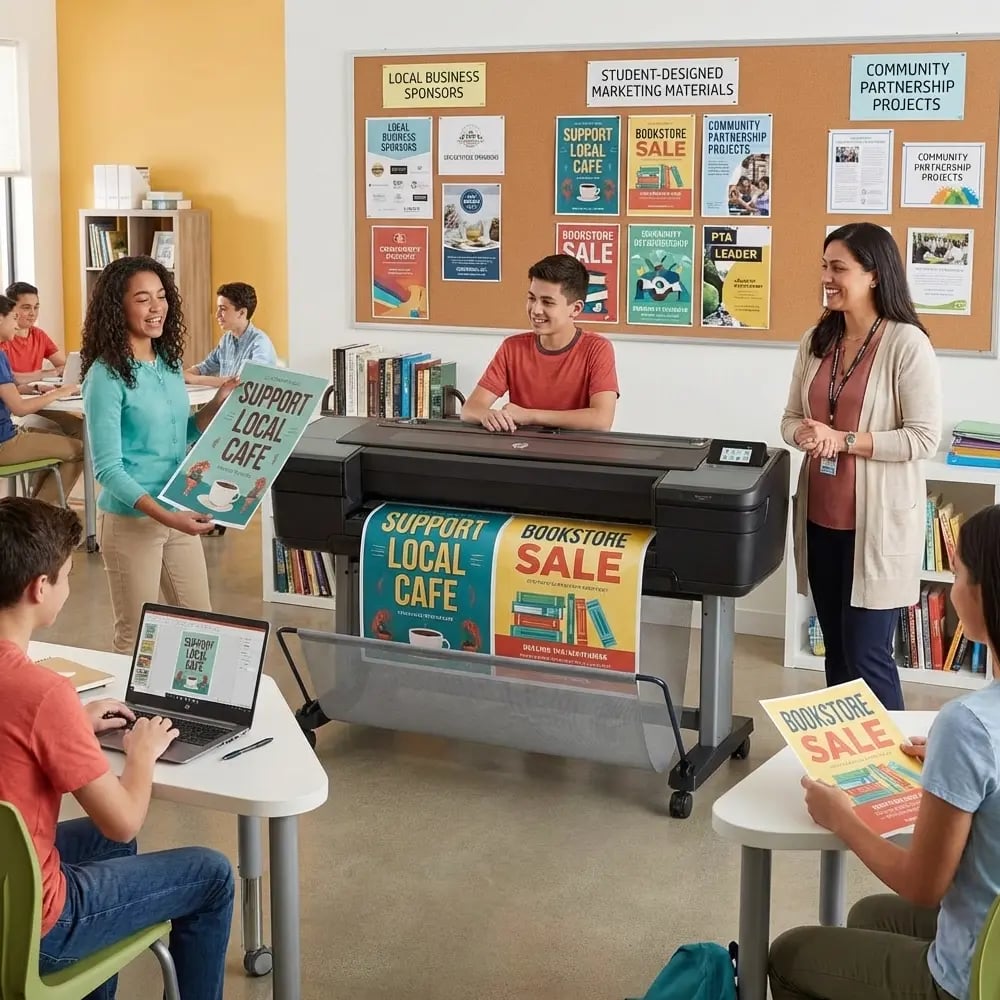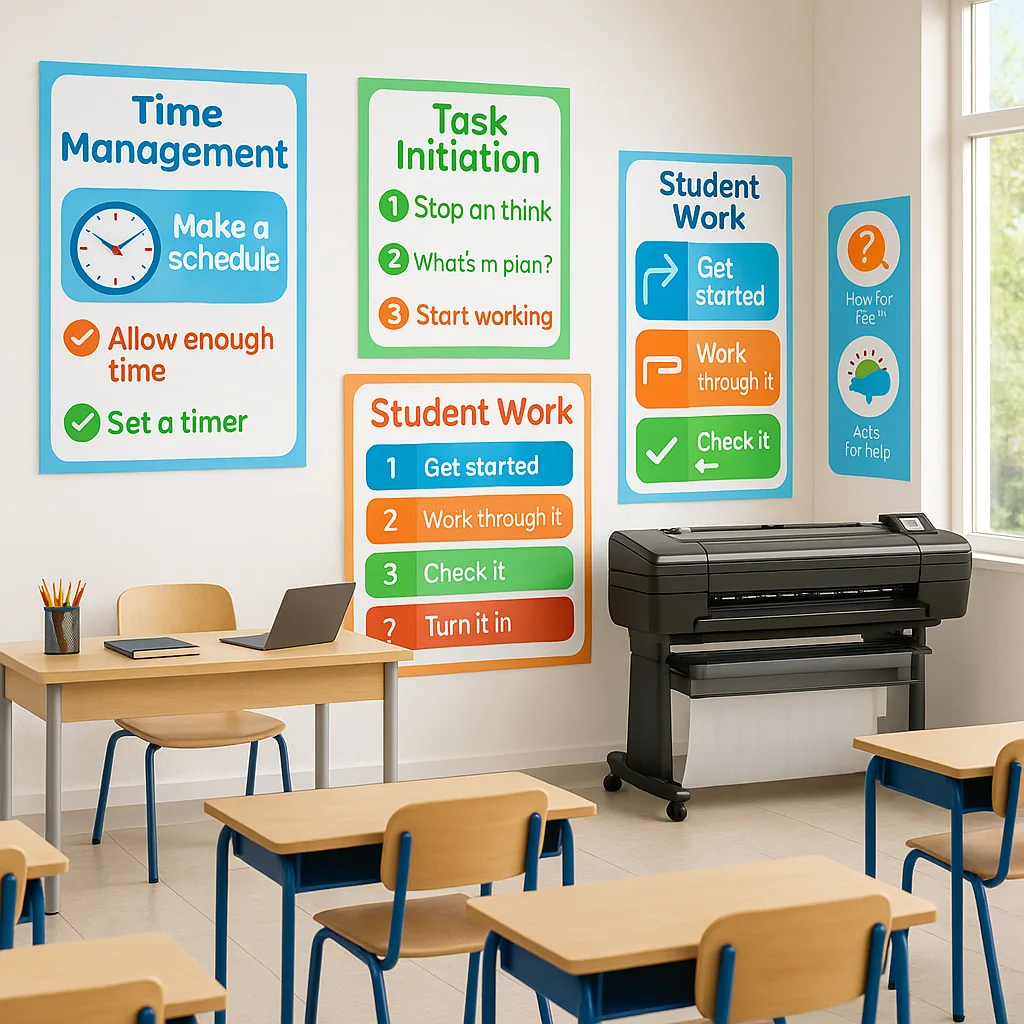
Standards-based grading represents one of the most significant shifts in California education over the past decade. Yet for many parents, this new system feels like learning a foreign language. Traditional letter grades are gone, replaced by numbers and phrases like “approaching proficiency” that leave families scratching their heads. This is where poster makers for standards-based grading become essential tools for bridging the communication gap between educators and families.
Understanding the Challenge: Why Parents Struggle with Standards-Based Grading
The disconnect between what schools communicate and what parents understand creates real barriers to student success.
At Lincoln Elementary in Sacramento, parent coordinator Maria Gonzalez noticed something troubling during fall conferences. Parent after parent left meetings confused about their child’s progress reports. “My daughter has all 3s—is that good or bad?” became the refrain. The shift from A-B-C grades to 1-4 proficiency scales had left families unable to interpret their children’s academic standing.
This scenario plays out in districts across California as schools implement standards-based grading to align with state frameworks. While educators understand that a “3” means “proficient” and indicates grade-level mastery, parents often interpret it as average or even below-average performance. Without clear visual communication tools, this misunderstanding undermines the very purpose of standards-based grading: providing specific feedback about student learning.
The California Department of Education’s shift toward competency-based assessment reflects research showing that traditional letter grades often mask actual learning. However, the transition requires extensive parent education. A 2023 CDE survey found that 68% of parents felt less informed about their child’s progress under standards-based systems compared to traditional grading.
Breaking Down Proficiency Scales with Visual Tools
Effective parent communication requires translating educational jargon into accessible language. Visual posters serve as permanent reference points that families can understand at a glance. Here’s how schools are using poster makers for schools to create clarity:
The Four-Level Framework
Most California districts use a four-point scale aligned with state standards:

Beginning
Student is starting to learn the standard
Developing
Making progress toward the standard
Proficient
Meets grade-level expectations
Exceeding
Demonstrates advanced understanding
Creating Effective Standards-Based Grading Posters
Successful visual communication about standards-based grading requires thoughtful design principles. Schools using classroom poster maker technology report higher parent understanding when following these guidelines:
Design Elements That Work
Color Coding Consistency
Establish a district-wide color system that matches report cards. Red for beginning, orange for developing, green for proficient, and blue for exceeding creates instant recognition. The Education Express 36 Poster Printer produces vibrant colors that remain consistent across all materials.
Real-World Examples
Instead of abstract descriptions, show what each level looks like in practice. For third-grade multiplication, a “proficient” example might show: “Solves 8 × 7 using strategies like repeated addition or arrays.”
Parent-Friendly Language
Replace educational terminology with everyday words. “Demonstrates conceptual understanding” becomes “Shows they understand the big idea.”
Implementation Strategies
Strategic Placement
Position posters where parents naturally gather: outside classrooms during pickup, near the attendance office, and in conference rooms. Create smaller handout versions using the Education Studio 24″ Package A+ for families to take home.
Multi-Language Accessibility
California’s diverse population requires materials in multiple languages. Design templates that easily accommodate translations while maintaining visual consistency.
QR Code Integration
Add QR codes linking to video explanations or district websites with detailed rubrics. This bridges print and digital communication effectively.
Transform Your School’s Communication Today
Join over 4,200 schools nationwide using Poster Studio Express to create clear, professional educational materials.
Sample Poster Templates for Standards-Based Communication
Math Standards
Reading Levels
Writing Progress
Maximizing Impact with Poster Makers for Standards-Based Grading
Schools achieving the highest parent satisfaction with standards-based grading share common practices in their visual communication strategies:
Professional Development Integration
Train teachers to reference wall posters during parent conferences. When explaining a child’s “approaching proficiency” status, pointing to specific examples on a poster clarifies expectations immediately. The Lifetime Design Service helps create custom posters matching your exact standards.
Student Involvement
Empower students to create their own understanding posters. Upper elementary students designing “What Proficiency Looks Like” displays develop metacognitive skills while producing authentic communication tools.
Consistent Messaging
Align all visual materials—from classroom posters to report card guides—using the same design language. This repetition builds familiarity and reduces confusion over time.

Funding Your Visual Communication Initiative
California schools have multiple funding streams available for communication tools that support standards-based grading implementation:
The Local Control Funding Formula specifically allocates resources for parent engagement initiatives. Districts must demonstrate how they’re improving communication with families, making poster makers for schools a qualifying expense. Similarly, Title I requires schools to spend at least 1% of their allocation on family engagement activities.
For English Language Learner populations, Title III funds can cover multilingual poster creation. The cost per print of just $1.30-$1.50 makes this an incredibly efficient use of federal dollars compared to outsourcing translation and design services.
Success Story: Riverside Unified’s Transformation
After implementing a comprehensive visual communication strategy using classroom poster maker systems, Riverside Unified saw parent understanding of standards-based grading increase from 34% to 89% in just one school year. Their secret? Consistent, clear visual messaging placed strategically throughout their schools.
“The ability to create professional-quality posters in-house transformed our parent communication,” reports Dr. Jennifer Martinez, Director of Curriculum. “We went from confused families to engaged partners in student learning.”
Moving Forward: Your Implementation Roadmap
Creating effective standards-based grading communication requires systematic planning. Follow this proven roadmap:
Phase 1: Assessment and Planning (Weeks 1-2)
Survey parents to identify specific confusion points. Review your current report cards and identify which standards need the most clarification. Form a committee including teachers, administrators, and parent representatives.
Phase 2: Design Development (Weeks 3-4)
Create poster templates that align with your report card format. Use the demo video to see how easy the design process can be. Ensure all materials reflect your school’s visual identity while maintaining clarity.
Phase 3: Production and Placement (Weeks 5-6)
Print initial poster sets for high-traffic areas. Create smaller handout versions for parent folders. Develop QR-linked digital resources to extend the reach of your print materials.
Phase 4: Training and Launch (Weeks 7-8)
Train staff on using posters during parent interactions. Host parent information nights featuring the new visual aids. Gather feedback and refine designs based on community response.
Phase 5: Ongoing Refinement
Monitor parent understanding through regular surveys. Update posters as standards evolve. Expand successful designs to cover additional subject areas.
Ready to Transform Parent Communication?
Join thousands of California schools already using poster makers for standards-based grading communication. Schedule your personalized demonstration today and see how easy it is to create professional, parent-friendly visual aids that clarify student progress.
See a live demonstration of how our poster makers create stunning standards-based grading materials in minutes, not hours.
Conclusion: Building Bridges Through Visual Communication
Standards-based grading represents the future of meaningful assessment in California schools. However, its success depends entirely on parent understanding and support. By investing in clear visual communication tools, schools transform confusion into clarity and frustration into partnership.
The shift from traditional letter grades to proficiency scales doesn’t have to leave families behind. With the right poster makers for standards-based grading, every school can create a visual bridge between educational best practices and parent comprehension. When families understand how their children are progressing, they become active partners in the learning journey.
Your students deserve assessment that truly reflects their learning, and your families deserve communication that helps them support that learning at home. Take the first step toward clearer communication today. The investment in visual communication tools pays dividends in increased parent engagement, reduced confusion, and ultimately, improved student achievement.







